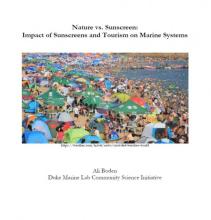
Active ingredients in sunscreens are UV filters, and recent studies have shown that the active ingredients can block UV light on photosynthesizing marine organisms. For example, recent studies found that when sunscreen runs off skin as beachgoers jump in the water, it can settle on top of corals, blocking the UV light. These findings have led to Hawaii and Palau to ban the sale and use of sunscreens containing the most harmful chemical UV filters.
About this lesson plan
This lesson plan introduces high school AP Environmental Science students to the concepts of sunscreen runoff and the implications it can have for nature. Students will apply sunscreen water to classroom plants, and then explore and draw conclusions on the different ways UV filters can affect plants and corals that are reliant on photosynthesis. This experiential-based learning activity will allow students to consider the ways their daily activities can affect downstream marine life.
This lesson plan is designed to fulfill North Carolina ’s Earth/Environmental Science Essential Standard, E.En 2.7.3: Explain how human activities impact the biosphere, while also providing for scientific method and hypothesis testing experience.
This lesson was developed by Ali Boden in collaboration with the Community Science Initiative at the Duke University Marine Lab, the North Carolina Scientific Research and Education Network, and a Science Collaborative research project team.